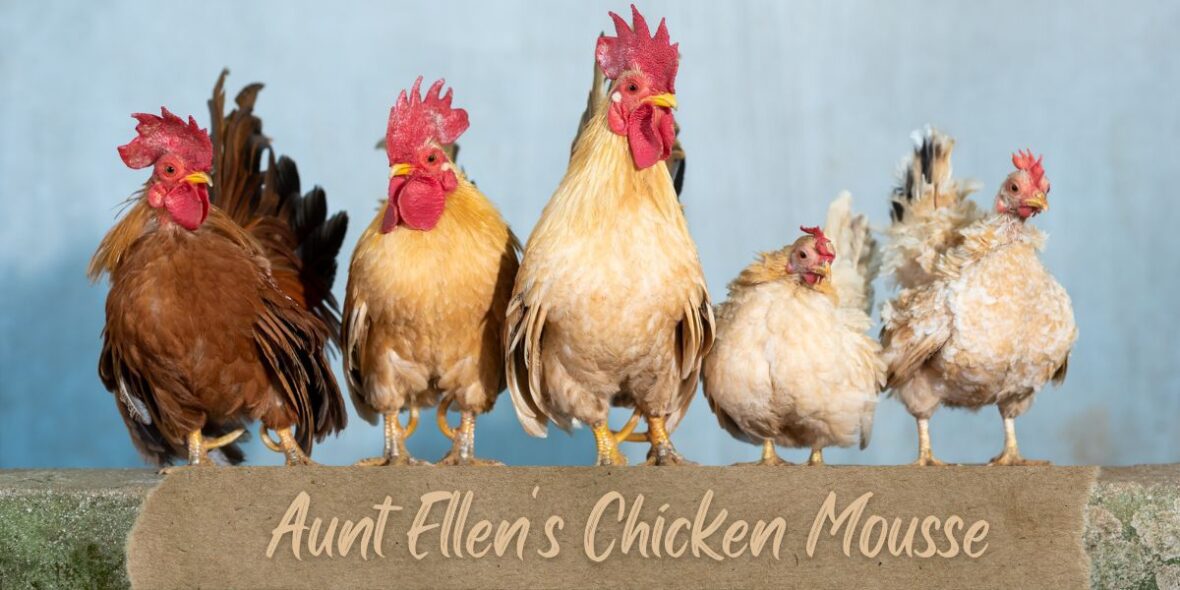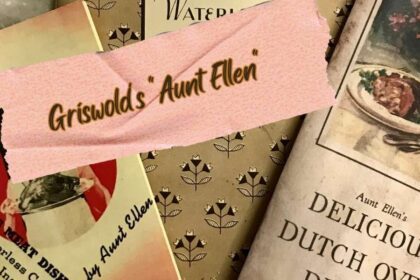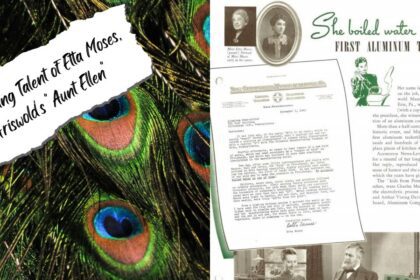I scoured all of Aunt Ellen’s1 recipes looking for ones I was willing to try. Her recipe for chicken mousse was by far the scariest to me.
Here is Aunt Ellen’s recipe for “Chicken Mousse” in its entirety:
Chop finely in the Griswold chopper enough chicken to have two cupfuls. Soften a tablespoon gelatin in 1/4 cup cold water and add 1/2 cupful boiling water to it with 1 teaspoon grated lemon rind and 1 tablespoonful lemon juice. Stir til slightly cool. Add this to chopped meat and salt, pepper to taste. Fold in 1 cupful stiffly whipped cream, and some chopped cooked asparagus, or 1/2 cupful peas, or 3 or 4 canned mushrooms, or canned pimentos, for trimming. Put in mould or casserole rinsed in cold water, and set aside to stiffen. Serve on platter, with cup-shaped lettuce leaves filled with beet, potato, or other colorful salad. (Stiffly beaten egg-whites can be substituted for the heavy cream in this recipe).
Now, there isn’t anything in this dish that I inherently hate; it’s just the combination that scares me. I am quite certain that I have never before made a molded meat dish.
I am nothing if not adventurous. It’s just that I’m not food adventurous. I’m more the mountain-climbing kind of adventurous. This was a big test for me.
My Elaborate Chicken Mousse-Making

I ran off to the local thrift store and found a sweet copper fish mold for $4. I realize that the fish mold was more likely intended to mold some kind of salmon spread or something fish or seafood-related (as opposed to a chicken mousse), but it was the only one there and I wasn’t about to be fussy.
Next to the grocery store, where I picked up unflavored gelatin (another first for me), about a pound of ground chicken breast, eggs, a lemon, canned beets, and romaine lettuce.
I thought about getting canned chicken, but that scares me. How can canned chicken be a good thing? What in the world is in that can that keeps the chicken from going bad? I don’t know and don’t want or need to know. I just know it is something I am not going to ingest.
I digress.
Aunt Ellen suggests chopping the chicken in a Griswold chopper. I decided that ground chicken would suffice. Plus, it was less expensive than buying a rotisserie chicken and cutting it up. I didn’t want to spend tons of money on this little experiment.
Even though she didn’t say so, I presumed that Aunt Ellen wanted the chicken to be cooked and not raw, so I set about doing just that in my Griswold no. 8 large block logo EPU smooth-bottom cast iron skillet. Because of COURSE if you are making an Aunt Ellen recipe, it must be made in Griswold products to rival her masterpieces.
As the chicken cooked, I followed Aunt Ellen’s instructions and dissolved a little packet of gelatin in 1/4 c cold water (I guessed it was 1T), then added 1/2 c boiling water. I stirred it a bit to cool, then zested some lemon rind into the mixture. To top it off, I juiced the lemon into the bowl.
Aunt Ellen gave the option of using either whipped cream or beaten egg whites in the
I separated four eggs, putting the whites in a small bowl. I used a hand mixer to whip them up to firm peaks. Four eggs made more than the 1 cup of whites called for by Aunt Ellen, but I presumed extra egg whites wouldn’t hurt anything. I didn’t know if it would help anything, but I didn’t think it would hurt. Besides, I had a fish mold to fill.
Aunt Ellen suggested either peas, asparagus, “3 or 4 canned mushrooms” or pimentos “for trimming.” I don’t know what “trimming” a gelatin mold means, so I hoped that just adding the vegetable to the mixture would work.
I added 1/2 c frozen peas (plus some extra that spilled into the mixture) to the chicken. Of the choices given by Aunt Ellen, that seemed the least distasteful to me. I added a bit of salt and pepper and poured the gelatin/lemon mixture into the skillet and gave it a stir or two.
I next gently folded the egg whites into the mixture in the skillet and then spooned the mixture into the fish mold. I rinsed the mold before filling it as Aunt Ellen directed, but I don’t know what purpose that served. I worried momentarily about whether I should spray the mold with Pam or something, but Aunt Ellen didn’t tell me to grease the pan, so I didn’t. I smoothed the top surface with the spatula so that it would sit relatively flat on a platter.
Off to the refrigerator it went.
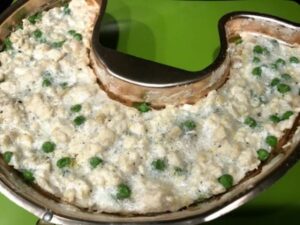
After about an hour, I touched my thumb to the mixture in the mold. The egg whites popped under my thumb, so I guessed it wasn’t ready. Back it went into the fridge.
The Deep Dive into Chicken Mousse-dom
As I was waiting for my mousse to finish setting (which I have never done before), I started doing a bit of googling. Who knew!?! Chicken mousse is actually a “thing!” Alton Brown makes a chicken liver mousse. Another site makes a tasty-sounding rustic appetizer with chicken and mushroom mousse on toasted ciabatta bread. Today’s chicken mousse uses a food processor to make the mousse creamy. In the 1920s, Aunt Ellen did not have a food processor. She just had the Griswold chopper and probably a hand-crank mixer.
I noticed that the other recipes with recipes for chicken mousse did not use egg whites; they used the heavy cream which Aunt Ellen suggested (but said could be substituted with beaten egg whites). And then, I PANICKED. You can’t eat raw egg whites, can you? I don’t want to die of salmonella!
I should have used heavy cream. Given that I didn’t expect I would be inclined to gobble down the entire fish-mold-full of Aunt Ellen’s chicken mousse, however, I figured I could swallow just a bit of the raw egg white and it wouldn’t kill me (would it? I felt very adventurous, indeed.)
More googling ensued. I found a recipe that suggested that I could imbibe a bit of raw egg white without contracting salmonella and dying. Moreover, didn’t I read somewhere that some athletes put raw egg whites into their protein drinks? They are still alive, aren’t they?
Still more googling followed, trying to learn whether the particular eggs I had purchased were pasteurized. The search was inconclusive, solidifying my resolve to have just a wee taste of my fish-mold chicken mousse. Again, however, there wasn’t much chance of me loving
The Glorious Aunt Ellen Chicken Mousse
Fast forward to the next morning. I could see that the mousse had set. I waited until the afternoon, when I was really really really hungry, to de-mold my mousse.
I used a small spatula to release the edges of the mousse mixture from the mold.
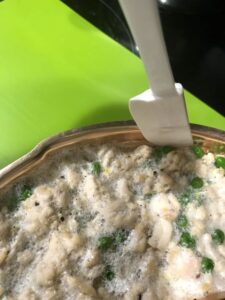
I happened to have a lettuce green plastic cooking
The peas add such a precious touch. My mold was done so well that you can see the scales on my chicken fish. Kind of similar, as an aside, to the 1888 newspaper article about a freshly-caught fish that had imprints of a waffle iron left on it.
Aunt Ellen suggested serving the chicken mousse alongside “cupped” lettuce leaves with either beet, potato, or “other colorful salad.” I got right to it. Ripped up some romaine lettuce leaves, opened a can of beets, and before you know it I had a simply lovely presentation! 2 Another first – I’ve never touched canned beets before.
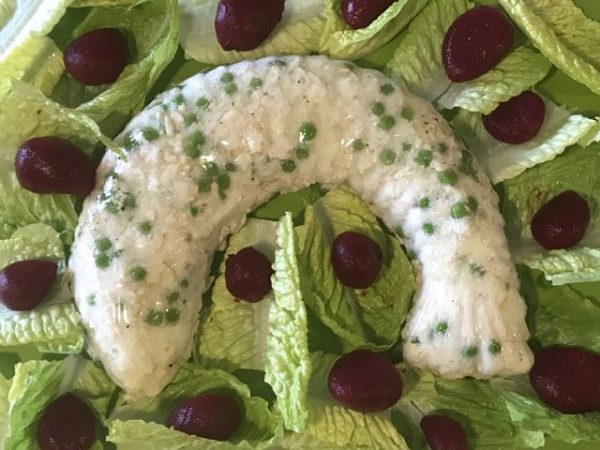
The mousse had an unappetizing smell to it. I’m not sure what the smell was, but it certainly didn’t encourage my tastebuds to dive in.
I did, however, taste it. I did not gag. I swallowed two bites. The lemony/gelatin/chicken mix was … not at all my cup of tea. But I tried it!
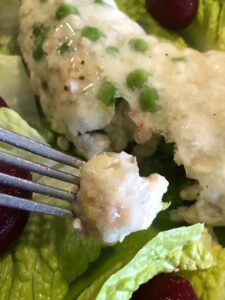
I did not love the combination of gelatin with chicken. I also did not contract salmonella, and I did not die. I did wonder, however, why I tried to make this mousse.
I have lived another day to try yet another of Aunt Ellen’s recipes!
